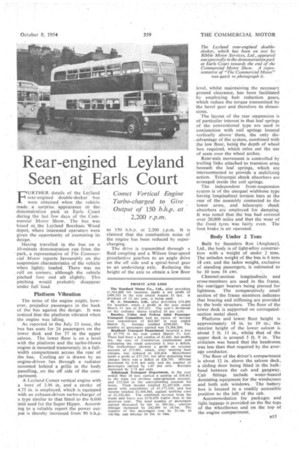Rear-engined Leyland Seen at Earls Court
Page 49

If you've noticed an error in this article please click here to report it so we can fix it.
FURTHER details of the Le:l)aad rear-engined double-decker bus were obtained when the , vehicle made . a surprise appearance in . the demonstration park at Earls Court during the last few days of the Corn. mercial Motor Show. The bus was based at the Leyland Boreham Wood depot, where interested operators were given the opportunity of examining its design.
Having travelled in the bus on a 10-minute demonstration run fromthe park, a representative of The Commercial Motor reports favourably on the suspension characteristics of the vehicle when lightly loaded. There was no roll on corners, although the vehicle pitched fore and aft slightly. This pitching would probably disappear under full load. .
Platform Vibration
The noise of the engine might, however, prejudice passengers in the back of the bus against the design. It was noticed that the platform vibrated when the engine was idling.
As reported in the July 23 issue, the bus has seats for 24 passengers on the lower deck and for 37 in the upper saloon. The lower floor is on a level with the platform and the turbo-blown engine is mounted transversely in a fullwidth compartment across the rear of the bus. Cooling air is drawn by an engine-driven fan through a radiator mounted behind a grille in the body panelling, on the tiff side of the compartment.
A Leyland Comet vertical engine with a bore of 3.96 in. and a stroke of 4.75.in, is employed, which is equipped with an exhaust-driven turbo-charger of a type similar to that fitted to the 0.600 -Unit used for the Super Hippo, According to a reliable report the power output is thereby increased from 90 b.h,p.
to 150 b.h.p. at 2,200 r.p.m. It is claimed that the combustion noise of the engine has been reduced by supercharging.
The drive is transmitted through a fluid coupling and a Wilson four-speed preselective gearbox to an angle drive on the off side and a spiral-bevel gear to an underslung axle. Reducing the height of the axle to obtain a low floor level, whilst maintaining the necessary ground clearance, has been facilitated by employing hub reduction gears, which reduce the torque transmitted by the bevel gear and therefore its dimensions.
The layout of the rear suspension is of particular interest in that leaf springs of the conventional type are used in conjunction with coil springs located vertically above' them, the only dis advantage of the system, combined with the low floor, being the depth of wheel box required, , which rules out the use of seats over the wheel arches.
Rear-axle movement is controlled by trailing links attached to trunnion arms beneath the leaf springs, which are interconnected to provide a stabilizing action. Telescopic shock absorbers are arranged inside the coil springs.
The independent front-suspension system is of the unequal wishbone type having longitudinal torsion bars at the rear of the assembly connected to the lower arms, . and telescopic shock absorbers are employed for damping. It was noted that the bus had covered over 20,000 miles and that the wear of the front tyres was fairly even. The foot brake is air operated.
Body Under 2 Tons
Built by Saunders Roe (Anglesey), Ltd., the body is of light-alloy construction with a weight of under 2 tons. The unladen weight of the bus is 6 tons 18 cwt. and the laden weight, exclusive of standing passengers, is estimated to be 10 tons 16 cwt.
Channel-section longitudinals and cross-members are used in the frame, the outrigger bearers being pierced for lightness. The comparatively small section of the frame members indicates that bracing and stiffening are provided by the body structure. The floor of the lower deck is supported on corrugatedsection metal sheet..
Platform and lower floor height is approximately 18 in. to 19 in.; .the interior height of the lower saloon is about 5 ft. 11 in., whilst that of the upper deck is around 5 ft. 9 in. The criticism was heard that the headroom, was less than that required by the average conductor.
The floor of the driver's compartment is about 12 in. above the saloon deck, a sliding door being fitted in the bulkhead between the cab and gangway. Cab fittings include water-heated demisting equipment for the windscreen and both side windows. The battery box is located in a readily accessible position to the left of the cab. Accommodation for packages and light luggage is provided on the flat tops of the wheelboxes and on the top of the engine compartment.




























































































